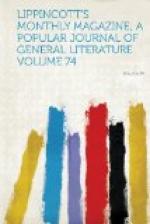of his text are the poetical quotations and exquisite
prose-bits from Ruskin, Swinburne, Symonds and others
whose pens sometimes turn into the pencil of a great
painter. The author’s own descriptions
are extremely faithful and charming. To those
who have made the journey from Florence to Rome a single
fine page of the introduction brings back a thrill
of that long ecstasy. In these few quiet words
he spreads Thrasymene before us: “It has
a soft, still beauty especially its own. Upon
the vast expanse of shallow pale-green waters, surrounded
by low-lying hills, storms have scarcely any effect,
and the birds which float over it and the fishing-boats
which skim across its surface are reflected as in
a mirror. At Passignano and Torricella picturesque
villages, chiefly occupied by fishermen, jut out into
the water, but otherwise the reedy shore is perfectly
desolate on this side, though beyond the lake convents
and villages crown the hills which rise between us
and the pale violet mountains beyond Montepulciano.”
Nothing can be more lifelike than the following picture
of the tract around Siena: “Scarcely do
we pass beyond the rose-hung walls which encircle
the fortifications than we are in an upland desert,
piteously bleak in winter, but most lovely when spring
comes to clothe it. The volcanic nature of the
soil in these parts gives a softer tint than usual
to the coloring. The miles upon miles of open
gray-green country, treeless, hedgeless, houseless,
swoop toward one another with the strangest sinuosities
and rifts and knobs of volcanic earth, till at last
they sink in faint mists, only to rise again in pink
and blue distances, so far off, so pale and aerial,
that they can scarcely be distinguished from the atmosphere
itself. Only here and there a lonely convent
with a few black cypress spires clustered round it,
or a solitary cross which the peasants choose as their
midday resting-place, cuts the pellucid sky.
Here in these great uplands, where all is so immense,
the very sky itself seems more full of space than elsewhere:
it is not the deep blue of the South, but so soft
and aerial that it looks as if it were indeed the
very heaven itself, only very far away.”
The chapter on Ravenna is the best in the book:
it is an admirable piece of work, a complete monograph.
Everything is there—history, legends, art—and
the quotations and illustrations are peculiarly beautiful
and convincing.
Mr. Hare, like many gentlemen of similar tastes and
tendencies, does not seem to have a strong sense of
humor, although now and then he condescends to smile
as he repeats some local legend, such as that of the
crucifix at S. Francesco delle Cariere, which awoke
an overwearied devotee, who had fallen asleep on his
knees before it, with “un soavissimo schiaffo,”
the gentlest slap, and bade him go to sleep in the
dormitory. He speaks of an ancient custom, not
mentioned by Murray, of harboring lost cats
in the cloister of San Lorenzo at Florence: “The
feeding of the cats, which takes place when the clock
strikes twelve, is a most curious sight.... From
every roof and arch and parapet-wall, mewing, hissing
and screaming, the cats rush down to devour.”
It sounds like a wicked parody on the poetic assembling
of the Venetian pigeons at the daily scattering of
grain in the square of St. Mark’s.




